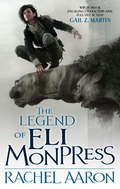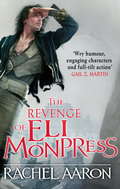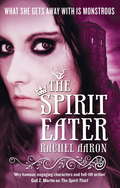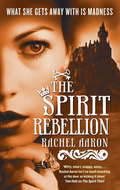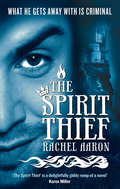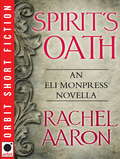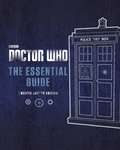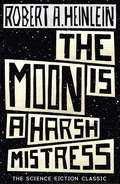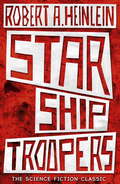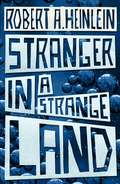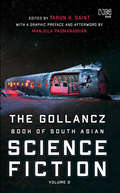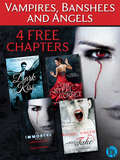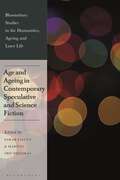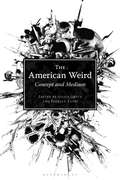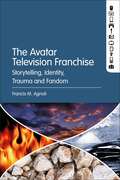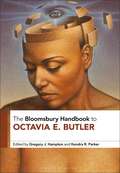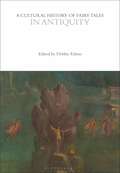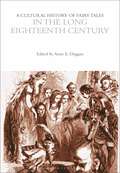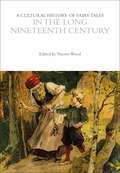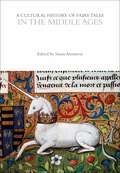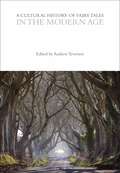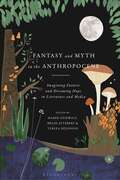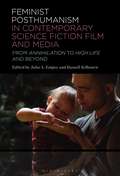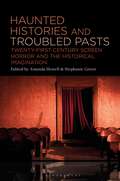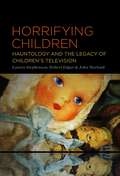- Table View
- List View
The Legend Of Eli Monpress: The Legend Of Eli Monpress (Legend of Eli Monpress #2)
by Rachel AaronEli Monpress is talented. He's charming. And he's a thief.But not just any thief. He's the greatest thief of the age, and he's also a wizard. And with the help of his partners - a swordsman with the most powerful magic sword in the world, and a demonseed who can step through shadows and punch through walls - he's going to put his grand plan into effect.Because Eli won't rest until he's amassed a fortune. Step one in his plan is to increase the bounty on his head, so he'll need to steal some big things. He'll start small for now though: he'll just steal something that no one will miss - at least for a while. Like a king . . .This omnibus edition contains: THE SPIRIT THIEF, THE SPIRIT REBELLION and THE SPIRIT EATER
The Revenge of Eli Monpress: An omnibus containing The Spirit War and Spirit's End (Legend of Eli Monpress #489)
by Rachel AaronEli Monpress is vain. He's cocky. And he's a thief.But he's a thief who has just seen his bounty topped and he's not happy about it. The bounty topper, as it turns out, is his best friend and master swordsman, Josef. He's been keeping secrets from Eli. Apparently, he's the only prince of a rather feisty country, and he's been ordered to come home to do his duty. This means throwing over personal ambitions like proving he's the greatest swordsman who ever lived. Family drama aside, Eli and Josef have their hands full. The Spirit Court has been usurped by the Council of Thrones and someone calling herself the Immortal Empress is staging a massive invasion. But it's not just politics - the Immortal Empress has a specific target in mind: Eli Monpress, the greatest thief in the world.This omnibus edition contains: THE SPIRIT WAR and SPIRIT'S END
The Spirit Eater: The Legend of Eli Monpress: Book 3 (Legend of Eli Monpress #3)
by Rachel AaronWith the pressure on after his success in Gaol, Eli Monpress, professional thief and degenerate, decides it's time to lie low for a bit. Taking up residence in a tiny seaside village, Eli and his companions seize the chance for some fun and relaxation.Nico, however, is finding it a bit hard. Plagued by a demon's voice in her head and feeling powerless, she only sees herself as a burden. Everyone's holiday comes to an untimely close, though, when Pele arrives to beg Eli's help for finding her missing father.But there are larger plans afoot than even Eli can see, and the real danger, and the solution, may lie with one of his own and her forgotten past.If only Nico could remember whose side she's on.
The Spirit Rebellion: The Legend of Eli Monpress: Book 2 (Legend of Eli Monpress #2)
by Rachel AaronEli Monpress is brilliant. He's incorrigible. And he's a thief.He's also still at large, which drives Miranda Lyonette crazy. While she's been kicked out of the Spirit Court, Eli's had plenty of time to plan his next adventure. But now the tables have turned, because Miranda has a new job - and an opportunity to capture a certain thief.Things are about to get exciting for Eli. He's picked a winner for his newest heist. His target: the Duke of Gaol's famous 'thief-proof' citadel. Eli knows Gaol is a trap, but what's life without challenges? Except the Duke is one of the wealthiest men in the world, a wizard who rules his duchy with an iron fist, and an obsessive perfectionist with only one hobby: Eli.It seems that everyone is hunting for Eli Monpress.
The Spirit Thief: The Legend of Eli Monpress: Book 1 (Legend of Eli Monpress #1)
by Rachel AaronEli Monpress is talented. He's charming. And he's a thief.But not just any thief. He's the greatest thief of the age - and he's also a wizard. And with the help of his partners - a swordsman with the most powerful magic sword in the world but no magical ability of his own, and a demonseed who can step through shadows and punch through walls - he's going to put his plan into effect.The first step is to increase the size of the bounty on his head, so he'll need to steal some big things. But he'll start small for now. He'll just steal something that no one will miss - at least for a while.Like a king.
Spirit's Oath: An Eli Monpress Novella (Legend of Eli Monpress)
by Rachel AaronFour years before the events of The Spirit Thief, Miranda Lyonette was a young apprentice Spiritualist on the cusp of a promising career. But on the eve of her return from bonding a wind spirit, a night that should have been a celebration, she finds instead that her father has come to take her home. Now, Miranda must choose between her duty to her family and her future at the Spirit Court. But while she's trying to make her parents see reason and avoid an arranged marriage to a man she can't stand, she stumbled across the one spirit who needs her more than any other, a caged ghosthound who doesn't want her help. To save him, Miranda will have to earn the dog's trust, but what she gets in return is a friendship deeper than anything she expected.
Doctor Who: The Handbook (Doctor Who)
by N A UnknownA new edition of the ultimate and most essential guide to Doctor Who, now updated to include all twelve incarnations of the Doctor and covering all his newest adventures from Series 8 and 9. With fascinating facts from all of space and time, as well as information on the Doctor's helpful companions and fearsome foes, this book will tell all about the Doctor's TARDIS, his regenerations, and much, much more!
The Moon is a Harsh Mistress (S. F. Masterworks Ser. #No. 7)
by Robert A. HeinleinIn 2075, the Moon is no longer a penal colony. But it is still a prison... Life isn't easy for the political dissidents and convicts who live in the scattered colonies that make up lunar civilisation. Everything is regulated strictly, efficiently and cheaply by a central supercomputer, HOLMES IV. When humble technician Mannie O'Kelly-Davis discovers that HOLMES IV has quietly achieved consciousness (and developed a sense of humour), the choice is clear: either report the problem to the authorities... or become friends. And perhaps overthrow the government while they're at it. The Moon is a Harsh Mistress has been called Robert A. Heinlein's crowning achievement. His best-known novels include Starship Troopers Mistress and Stranger in a Strange Land.
Starship Troopers (S. F. Masterworks Ser.)
by Robert A. Heinlein5,000 years in the future, humanity faces total extermination. Our one defence: highly-trained soldiers who scour the metal-strewn blackness of space to hunt down a terrifying enemy: an insect life-form known only as 'Bugs.' This is the story of trooper Johnny Rico, from his idealistic enlistment in the infantry of the future through his rigorous training to the command of his own platoon. And his destiny is a war that will span the galaxy. Robert A. Heinlein announced himself as a master of modern science fiction with Starship Troopers, his controversial take on modern military politics. His best-known novels include The Moon is a Harsh Mistress and Stranger in a Strange Land
Stranger in a Strange Land
by Robert A. HeinleinThe original uncut edition of STRANGER IN A STRANGE LAND by Hugo Award winner Robert A Heinlein - one of the most beloved, celebrated science-fiction novels of all time. Epic, ambitious and entertaining, STRANGER IN A STRANGE LAND caused controversy and uproar when it was first published and is still topical and challenging today. Twenty-five years ago, the first manned mission to Mars was lost, and all hands presumed dead. But someone survived... Born on the doomed spaceship and raised by the Martians who saved his life, Valentine Michael Smith has never seen a human being until the day a second expedition to Mars discovers him. Upon his return to Earth, a young nurse named Jill Boardman sneaks into Smith's hospital room and shares a glass of water with him, a simple act for her but a sacred ritual on Mars. Now, connected by an incredible bond, Smith, Jill and a writer named Jubal must fight to protect a right we all take for granted: the right to love.
The Gollancz Book of South Asian Science Fiction Volume 2
byFrom sinister plans of xenocide to speciesists who have taken it upon themselves to Off-World those unlike them; from simulations that memorialize stories obliterated by a book-burning world to the Master Pain Merchant who is always at hand to administer a dose of long-forgotten sensations; from genetically modified Glow Girls who can kill with a touch to a droid detective actively seeking out justice - this stellar volume of cutting-edge science fiction showcases, in prose and verse, 32 of the most powerful voices in the genre from the Indian Subcontinent.Taking forward the formidable task achieved to critical acclaim by the first volume of The Gollancz Book of South Asian Science Fiction, the present collection masterfully transports readers to worlds strangely familiar, raises crucial questions about the place of humans in the universe, and testifies to the astonishing range and power of the imaginative mind.
Age and Ageing in Contemporary Speculative and Science Fiction (Bloomsbury Studies in the Humanities, Ageing and Later Life)
Focusing on the contemporary period, this book brings together critical age studies and contemporary science fiction to establish the centrality of age and ageing in dystopian, speculative and science-fiction imaginaries. Analysing texts from Europe, North America and South Asia, as well as television programmes and films, the contributions range from essays which establish genre-based trends in the representation of age and ageing, to very focused studies of particular texts and concerns. As a whole, the volume probes the relationship between speculative/science fiction and our understanding of what it is to be a human in time: the time of our own lives and the times of both the past and the future.
The American Weird: Concept and Medium
Hitherto classified as a form of genre fiction, or as a particular aesthetic quality of literature by H. P. Lovecraft, the weird has now come to refer to a broad spectrum of artistic practices and expressions including fiction, film, television, photography, music, and visual and performance art. Largely under-theorized so far, The American Weird brings together perspectives from literary, cultural, media and film studies, and from philosophy, to provide a thorough exploration of the weird mode. Separated into two sections – the first exploring the concept of the weird and the second how it is applied through various media – this book generates new approaches to fundamental questions: Can the weird be conceptualized as a generic category, as an aesthetic mode or as an epistemological position? May the weird be thought through in similar ways to what Sianne Ngai calls the zany, the cute, and the interesting? What are the transformations it has undergone aesthetically and politically since its inception in the early twentieth century? Which strands of contemporary critical theory and philosophy have engaged in a dialogue with the discourses of and on the weird? And what is specifically “American” about this aesthetic mode?As the first comprehensive, interdisciplinary study of the weird, this book not only explores the writings of Lovecraft, Caitlín Kiernan, China Miéville, and Jeff VanderMeer, but also the graphic novels of Alan Moore, the music of Captain Beefheart, the television show Twin Peaks and the films of Lily Amirpour, Matthew Barney, David Lynch, and Jordan Peele.
The Avatar Television Franchise: Storytelling, Identity, Trauma, and Fandom
Nickelodeon's Avatar: The Last Airbender (2005-08) and its sequel The Legend of Korra (2012-14) are among the most acclaimed and influential U.S. animated television series of the 21st century. Yet, despite their elevated status, there have been few academic works published about them. The Avatar Television Franchise: Storytelling, Identity, Trauma, Fandom and Reception remedies this gap by bringing together a wide range of scholarly writings on these shows. This edited collection is comprised of 13 chapters organized into 4 sections, featuring close readings of key episodes, analyzing how they create meaning as well as illustrating how established theories can guide those readings. Some chapters explore different theories relating to identity as well as considering the repercussions of depicting real-world identities in these shows, while others examine the various manifestations of trauma from throughout the franchise as well as illustrates different scholarly approaches to the topic. Still others utilize fan studies to understand the myriad ways viewers have responded to and interpreted the Avatar franchise.
The Bloomsbury Handbook to Octavia E. Butler
Octavia E. Butler is widely recognized today as one of the most important figures in contemporary science fiction. Bringing together leading and emerging scholars and covering Butler's complete works from the bestselling novel Kindred, to her short stories and major novel sequences Patternmaster, Xenogenesis and The Parables, this is the most comprehensive Companion to Butler scholarship available today.The Bloomsbury Handbook to Octavia E. Butler covers the full range of contemporary scholarly themes and approaches to the author's work, including:· Cyborgs and the posthuman· Race and African American history· Afrofuturism· Gender and sexuality· New perspectives from Religious Studies, the Environmental Humanities and Disability Studies· New discoveries from the Butler archives at the Huntington LibraryThe book includes a comprehensive bibliography of works by Butler and secondary scholarship on her work as well as an afterword by the novelist Tananarive Due.
A Cultural History of Fairy Tales in Antiquity (The Cultural Histories Series)
How have fairy tales from around the world changed over the centuries? What do they tell us about different cultures and societies? Spanning chronologically from the third millennium BCE through to the seventh century CE and beyond, and geographically from the Mediterranean to the Near East and Asia, this book explores the earliest known evidence of familiar folk tales and fairy tales in the ancient world.Drawing on sources including the Rig Veda, the Epic of Gilgamesh, the Old Testament, the Westcar Papyrus, and the Odyssey, this volume ranges from epic poetry to drama, to fables and proverbs, and from ancient histories to novels.Scholars in Classics, Anthropology, Folklore, and Asian Studies examine the dissemination, adaptation, and cross-cultural interactions of early forms of folk tales, providing new insights into how they functioned and circulated across different societies.An essential resource for scholars and students of ancient literature, history, and cultural studies, this book explores topics including: forms of the marvelous, gender and sexuality, monsters and the monstrous, the significance of spaces, socialization and moral messaging, and the uses and abuses of power.
A Cultural History of Fairy Tales in the Long Eighteenth Century (The Cultural Histories Series)
How have fairy tales from around the world changed over the centuries? What do they tell us about different cultures and societies?This volume traces the evolution of the genre over the period known as the long eighteenth century. It explores key developments including: the French fairy tale vogue of the 1690s, dominated by women authors including Marie-Catherine d'Aulnoy and Marie-Jeanne Lhéritier, the fashion of the oriental tale in the early eighteenth century, launched by Antoine Galland's seminal translation of The Thousand and One Nights from Arabic into French, and the birth of European children's literature in the second half of the eighteenth century. Drawing together contributions from an international range of scholars in history, literature and cultural studies, this volume examines the intersections between diverse national tale traditions through different critical perspectives, producing an authoritative transnational history of the genre. An essential resource for researchers, scholars and students of literature, history and cultural studies, this book explores such themes and topics as: forms of the marvelous, adaptation, gender and sexuality, humans and non-humans, monsters and the monstrous, spaces, socialization, and power.A Cultural History of Fairy Tales (6-volume set)A Cultural History of Fairy Tales in Antiquity is also available as a part of a 6-volume set, A Cultural History of Fairy Tales, tracing fairy tales from antiquity to the present day, available in print, or within a fully-searchable digital library accessible through institutions by annual subscription or on perpetual access (see www.bloomsburyculturalhistory.com). Individual volumes for academics and researchers interested in specific historical periods are also available digitally via www.bloomsburycollections.com.
A Cultural History of Fairy Tales in the Long Nineteenth Century (The Cultural Histories Series)
How have fairy tales from around the world changed over the centuries? What do they tell us about different cultures and societies?This volume explores the period when the European fairy tales conquered the world and shaped the global imagination in its own image. Examining how collectors, children's writers, poets, and artists seized the form to challenge convention and normative ideas, this book explores the fantastic imagination that belies the nineteenth century's materialist and pedestrian reputation. Looking at writers including E.T.A Hoffman, the Brothers Grim, S.T. Coleridge, Walter Scott, Oscar Wilde, Christina Rosetti, George MacDonald, and E. Nesbit, the volume shows how fairy tales touched every aspect of nineteenth century life and thought. It provides new insights into themes including: forms of the marvelous, adaptation, gender and sexuality, humans and non-humans, monsters and the monstrous, spaces, socialization, and power. With contributions from international scholars across disciplines, this volume is an essential resource for researchers, scholars and students of literature, history, and cultural studies.A Cultural History of Fairy Tales (6-volume set)A Cultural History of Fairy Tales in Antiquity is also available as a part of a 6-volume set, A Cultural History of Fairy Tales, tracing fairy tales from antiquity to the present day, available in print, or within a fully-searchable digital library accessible through institutions by annual subscription or on perpetual access (see www.bloomsburyculturalhistory.com). Individual volumes for academics and researchers interested in specific historical periods are also available digitally via www.bloomsburycollections.com.
A Cultural History of Fairy Tales in the Middle Ages (The Cultural Histories Series)
How have fairy tales from around the world changed over the centuries? What do they tell us about different cultures and societies? Spanning the years from 900 to 1500 and traversing geographical borders, from England to France and India to China, this book uniquely examines the tales told, translated, adapted and circulated during the period known as the Middle Ages. Scholars in history, literature and cultural studies explore the development of epic tales of heroes and monsters and enchanted romance narratives. Examining how tales evolved and functioned across different societies during the Middle Ages, this book demonstrates how the plots, themes and motifs used in medieval tales influenced later developments in the genre. An essential resource for researchers, scholars and students of literature, history and cultural studies, this volume explores themes including: forms of the marvelous, adaptation, gender and sexuality, humans and non-humans, monsters and the monstrous, spaces, socialization, and power.A Cultural History of Fairy Tales (6-volume set)A Cultural History of Fairy Tales in Antiquity is also available as a part of a 6-volume set, A Cultural History of Fairy Tales, tracing fairy tales from antiquity to the present day, available in print, or within a fully-searchable digital library accessible through institutions by annual subscription or on perpetual access (see www.bloomsburyculturalhistory.com). Individual volumes for academics and researchers interested in specific historical periods are also available digitally via www.bloomsburycollections.com.
A Cultural History of Fairy Tales in the Modern Age (The Cultural Histories Series)
How have fairy tales from around the world changed over the centuries? What do they tell us about different cultures and societies?Drawing together contributions from an international range of scholars in history, literature, and cultural studies, this volume uniquely examines creative applications of fairy tales in the twentieth and twenty-first centuries. It explores how the fairy tale has become a genre that flourishes on film, on TV, and in digital media, as well as in the older technologies of print, performance, and the visual arts. An essential resource for researchers, scholars and students of literature, history, the visual arts and cultural studies, this book explores such themes and topics as: forms of the marvelous, adaptation, gender and sexuality, humans and non-humans, monsters and the monstrous, spaces, socialization, and power.A Cultural History of Fairy Tales (6-volume set)A Cultural History of Fairy Tales in Antiquity is also available as a part of a 6-volume set, A Cultural History of Fairy Tales, tracing fairy tales from antiquity to the present day, available in print, or within a fully-searchable digital library accessible through institutions by annual subscription or on perpetual access (see www.bloomsburyculturalhistory.com). Individual volumes for academics and researchers interested in specific historical periods are also available digitally via www.bloomsburycollections.com.
Fantasy and Myth in the Anthropocene: Imagining Futures and Dreaming Hope in Literature and Media
The first study to look at the intersection of the discourse of the Anthropocene within the two highly influential and perennially popular storytelling modes of fantasy and myth, this book articulates the idea that if humanity is to have a future, it needs stories that articulate visions of a biocentric, ecological civilization. As the two story systems that have been humanity's most advanced technologies for collective dreaming, fantastic fiction and myths are helping us adopt a biocentric lens, re-kin us with other forms of life, and assist us in the transition to an ecological civilization. Deliberately moving away from dystopian narratives toward anticipatory imaginations of sustainable futures, this volume blends chapters by top scholars in the fields of climate fiction, science fiction, fantasy, myth, and Young-Adult literature studies with personal reflections by award-winning authors and illustrators of speculative fiction for young audiences such as Jeff Vandermeer, Shaun Tan, Jane Yolen, Katherine Applegate and Joseph Bruchac.Covering the works of major fantasy authors such as J. R. R. Tolkien, Terry Prachett, J. K. Rowling, China Mieville, Barbara Henderson, Jeanette Winterson, John Crowly, Richard Powers, George R. R. Martin and Kim Stanley Robinson, and offering interrogations of cultural expressions set in or from the UK, USA, Nigeria, Ghana, Pacific Islands, New Zealand and Australia, this book frames fantasy and myth as spaces where visions of sustainable futures can be designed with most detail and nuance. Rather than merely criticizing the ecocidal status quo, the book asks how Fantastic stories can mobilize resistance around ideas necessary for the emergence of an ecological civilization.
Feminist Posthumanism in Contemporary Science Fiction Film and Media: From Annihilation to High Life and Beyond
Feminist Posthumanism in Contemporary Science Fiction Film and Media: From Annihilation to High Life and Beyond places posthumanism and feminist theory into dialogue with contemporary science fiction film and media. This essay collection is intimately invested in the debates around the posthuman and the critical posthumanities within a feminist critical-theoretical framework.In this posthumanist light, science fiction as a genre allows for new imaginings of human-technological relations, while it can also be the site of a critique of human exceptionalism and essentialism. In this way, science fiction affords unique opportunities for the scholarly investigation of the relevance and relative applicability of specific posthumanist themes and questions in a particularly rich and wide-ranging popular cultural field of production. One of the reasons for this suitability is the genre's historically longstanding relationship with the critical investigation of gender, specifically the position and relative empowerment of women. The original analyses presented here pay close attention to audiovisual style (including game mechanics), facilitating the critical interrogation of the issues and questions around posthumanism. Where typically the mention of SF in the posthumanist context calls to mind a whole set of (often clichéd) tropes-the cyborg, technologically augmented bodies, AI subjectivities, etc.-this volume's thirteen chapters analyze specific examples of contemporary SF cinema that engage in meaningful ways with the burgeoning field of critical posthumanism, and that utilize such films to interrogate posthumanist and feminist as well as humanistic ideas.
Haunted Histories and Troubled Pasts: Twenty-First-Century Screen Horror and the Historical Imagination
Haunted Histories and Troubled Pasts speaks to how a transnational array of recent screen entertainments participate, through horror, in public discourses of history, the social and creative work of reshaping popular understanding of our world through the lens of the past.Contemporary film and television – and popular screen cultures more generally – are distinguished by their many and varied engagements with history, including participation in worldwide movements to reconcile past losses and injuries with present legacies. The chapters in this collection address themselves to 21st-century screen horror's participation in this widespread fascination with and concern for the historical - its recurrent reimagining of the relation between the past and present, which is part of its inheritance from the Gothic. They are concerned with the historical work of horror's spectral occupations, its visceral threats of violence and its capacity for exploring repressed social identities, as well as the ruptures and impositions of colonization and nationhood.Trauma is a key theme in this book, examined through themes of war and genocide, ghostly invasions, institutionalized abuse, apocalyptic threat and environmental destruction. These persistent, fearful reimaginings of the past can take many lurid – sometimes tritely generic – forms. Together, these chapters explore and reflect upon horror's ability to speak through them to the unspoken of history, to push the boundaries and probe the fault-lines and ideological impositions of received historical narratives – while reminding us that history and the historical imagination persist as sites of contention.
Horrifying Children: Hauntology and the Legacy of Children’s Television
Horrifying Children examines weird and eerie children's television and literature via critical analysis, memoir and autoethnography.There has been an explosion of interest in the impact of children's television and literature of the late twentieth century. In particular, the 1970s, '80s and '90s are seen as decades that shaped a great deal of the contemporary cultural landscape. Television of this period dominated the world of childhood entertainment, drawing freely upon literature and popular culture, like the Garbage Pail Kids and Stranger Things, and much of it continues to resonate powerfully with the generation of cultural producers (fiction writers, screenwriters, directors, musicians and artists) that grew up watching the weird, the eerie and the horrific: the essence of 21st-century Hauntology. In these terms this book is not about children's television as it exists now, but rather as it features as a facet of memory in the 21st century. As such it is the legacy of these television programmes that is at the core of Horrifying Children. The 'haunting' of adults by what we have seen on the screen is crucial to the study. This collection directly addresses that which 'scared us' in the past insomuch as there is a correlation between individual and collective cultural memory, with some chapters providing an opportunity for situating existing explorations and understandings of Gothic and Horror TV within a hauntological and experiential framework.
